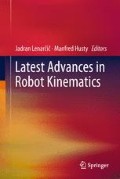Abstract
The left and right dual Moore–Penrose generalized inverses are the subject of this paper. It is shown that, contrary to the real case, these inverses are not unique, those with minimum Frobenius norm being obtained. Their application in kinematic synthesis is discussed. It is shown that, in the case of function-generating RCCC linkages, the left dual generalized inverse leads to a linkage that meets the prescribed input-output relations with both a least-square error and a minimum size. The study concludes with the synthesis of a linkage that approximates a homokinetic transmission between shafts with skew, orthogonal axes.
Access this chapter
Tax calculation will be finalised at checkout
Purchases are for personal use only
Notes
- 1.
Actually, the authors do not stress the difference between the right and the left generalized inverses; they represent both with the same symbol, \((\; \cdot\; )^{+}\).
- 2.
If e and e o denote the primal and dual parts of \(\hat{\mathbf{e}}\), then \(\|\hat{\mathbf {e}}\|^{2} = \|\mathbf{e}\|^{2} +\varepsilon2\mathbf{e}^{T} \mathbf{e}_{o}\).
- 3.
The new variable u i is introduced with the purpose of avoiding double subscripts.
- 4.
This high number was used with the purpose of bringing the optimum design error e 0 as close as possible to the structural error, which measures the actual deviation of the synthesized output angle from its prescribed value, as per the results reported in [14].
References
Pennestrì, E., Stefanelli, R.: Linear algebra and numerical algorithms using dual numbers. Multibody Syst. Dyn. 18(3), 323–344 (2007)
Angeles, J.: The application of dual algebra to kinematic analysis. In: Angeles, J., Zakhariev, E. (eds). Computational Methods in Mechanical Systems, vol. 161, pp. 3–31. Springer-Verlag, Heidelberg (1998)
Fischer, I.S.: Dual-Number Methods in Kinematics, Statistics and Dynamics. CRC Press, Boca Raton (1999)
Cheng, H.H., Thompson, S.: Dual polynomials and complex dual numbers for analysis of spatial mechanisms. In: Proc. (1996) ASME Design Engineering Technical Conference and Computers in Engineering Conference, Irvine, CA, August 18–22, Vol. 96-DET/MECH-1221 (1996)
Simmons, G.F.: Introduction to Topology and Modern Analysis. McGraw-Hill Book Co., New York (1963)
Dimentberg, F.M.: The Screw Calculus and Its Applications in Mechanics. Izdat. Nauka, Moscow (1965)
Kotel’nikov, A.P.: Screw Calculus and Some of Its Applications to Geometry and Mechanics [in Russian]. Annals of the Imperial University of Kazan (1895). 2006 edition by KomKniga, Moscow
Alizadeh, D., Ma, X.Q., Angeles, J.: On the reduction of the normality conditions in equality-constrained optimization problems in mechanics. Meccanica 47, 755–768 (2012)
Golub, G.H., Van Loan, C.F.: Matrix Computations. The Johns Hopkins University Press, Baltimore (1989)
Hartenberg, R.S., Denavit, J.: Kinematic Synthesis of Linkages. McGraw-Hill Book Company, New York (1964)
Yang, A., Freudenstein, F.: Application of dual-number quaternion algebra to the analysis of spatial mechanisms. J. Appl. Mech. 31, 300–307 (1964)
Bai, S.P., Angeles, J.: A unified input-output analysis of four-bar linkages. Mech. Mach. Theory 43, 240–251 (2008)
Alizadeh, D., Angeles, J., Nokleby, S.: Optimization of a spherical ‘homokinetic’ linkage with minimum design error and maximum transmission quality. In: Proc. 13th World Congress on the Theory of Machines and Mechanisms, Guanajuato, Gto., Mexico, June 20–22, Paper A-354 (2011)
Hayes, M.J.D., Parsa, K., Angeles, J.: The effect of data-set cardinality on the design and structural errors of four-bar function-generators. In: Proc. 10th World Congress on the Theory of Machines and Mechanisms, Oulu, Finland, June 20–24, vol. 1, pp. 437–442 (1999)
Freudenstein, F.: Approximate synthesis of four-bar linkages. Trans. ASME 77, 853–861 (1955)
Acknowledgements
The support provided by a James McGill Professorship is dutifully acknowledged. Partial support received from the NSERC (Canada’s Natural Sciences and Engineering Research Council) Discovery Grant 4532-2008 is equally acknowledged.
Author information
Authors and Affiliations
Corresponding author
Editor information
Editors and Affiliations
Rights and permissions
Copyright information
© 2012 Springer Science+Business Media Dordrecht
About this paper
Cite this paper
Angeles, J. (2012). The Dual Generalized Inverses and Their Applications in Kinematic Synthesis. In: Lenarcic, J., Husty, M. (eds) Latest Advances in Robot Kinematics. Springer, Dordrecht. https://doi.org/10.1007/978-94-007-4620-6_1
Download citation
DOI: https://doi.org/10.1007/978-94-007-4620-6_1
Publisher Name: Springer, Dordrecht
Print ISBN: 978-94-007-4619-0
Online ISBN: 978-94-007-4620-6
eBook Packages: EngineeringEngineering (R0)

